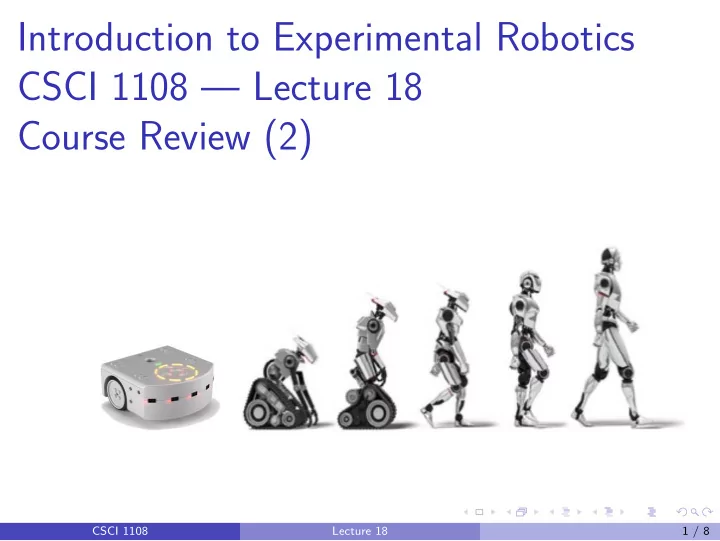

Introduction to Experimental Robotics CSCI 1108 — Lecture 18 Course Review (2) CSCI 1108 Lecture 18 1 / 8
Course Review (2) We will consider a few problems and their solutions, starting with some problems from Quiz 4. Some things to remember about STDs (State Transition Diagrams): Keep states simple, and put condition changes and actions in transitions Try to keep STD minimal Try to be reasonably precise about which sensors or events are relevant to transitions CSCI 1108 Lecture 18 2 / 8
Some Details to Remember Important sensors prox.horizontal[0-4] , prox.ground.delta[0-1] , button.forward (left, right, backward, center) prox sensors measure reflection: white gives high value, black low, more distant objects give lower values Important actuators: motor.left.target and right Remember LED lights top, circle CSCI 1108 Lecture 18 3 / 8
Problem 1: Draw a state transition diagram (STD) to model an Aseba program that will make the robot move in a cross pattern shown below. The robot comes to stop if it detects a black tape at any point on its path. Assume that the robot is started at a corner, all straight line segments are of equal length and all turns are 90 ◦ . CSCI 1108 Lecture 18 4 / 8
Problem 2: Draw a state transition diagram (STD) to model an Aseba program that will make the robot move in a cross pattern shown below. The robot comes to stop if it detects a black tape at any point on its path. Assume that the robot is started at a corner, all straight line segments are of equal length and all turns are 90 ◦ . CSCI 1108 Lecture 18 5 / 8
Problem 3: A robot is placed in a path with eight cells as shown below. The robot does not know its location but it knows all the cell colors. a) What localization probabilities can the robot assign to each cell on reading the ground sensor? b) What are the probabilities after the robot moves one cell forward and reads the ground sensor again? c) What are the probabilities after the robot moves one more cell forward and reads the grounds sensor again? A B C D E F G H (a) (b) (c) CSCI 1108 Lecture 18 6 / 8
Problem 4: A robot is placed in a path with eight cells as shown below. The robot does not know its location but it knows all the cell colors. a) What localization probabilities can the robot assign to each cell on reading the ground sensor? b) What are the probabilities after the robot moves one cell forward and reads the ground sensor again? c) What are the probabilities after the robot moves one more cell forward and reads the grounds sensor again? A B C D E F G H (a) (b) (c) CSCI 1108 Lecture 18 7 / 8
Problem 5: Draw a state transition diagrem (STD) to define behaviour of a robot so that it can find exit from a maze like the one shown. The robot should go forward until it approaches an obstacle. On a white obstacle, it should turn left 90 ◦ and continue forward, and on a black obstracle it should turn right 90 ◦ and continue forward. It should stop on driving over a black tape. Black obstacle Black tape EXIT White obstacle Black obstacle START CSCI 1108 Lecture 18 8 / 8
Recommend
More recommend